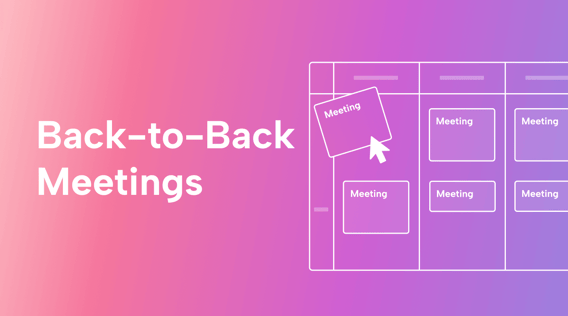Back-to-back meetings have become a norm in today’s corporate culture. While they can lead to information overload, when scheduled in a way that enables blocks of uninterrupted work and focused discussion time, they can be productive.
This article offers strategies for optimizing meeting schedules for your team so that even the most packed days can be both manageable and effective.
What are back-to-back meetings?
Back-to-back meetings are a sequence of meetings scheduled consecutively, with little to no break in between. They line up like dominos, one after another.
This lineup often means jumping straight from one discussion to the next without pausing to reflect or take a breather.
Back-to-back meetings are aimed at maximizing efficiency and productivity, but when managed poorly, they take up an entire day’s schedule.
Are back-to-back meetings effective?
With the increasing need for meetings in the corporate world, especially in the era of remote and hybrid work models, it begs the question: are back-to-back meetings really effective?
The upsides of back-to-back meetings
When strategically planned, back-to-back meetings can be highly effective and efficient. They capitalize on the momentum of continuous discussions and keep team members engaged and focused.
In remote or hybrid work environments, these meetings consolidate team communication into one cohesive block, eliminating the need for intrusive and sporadic check-ins throughout the day.
As a result, they can contribute to a more organized workweek, where team members can allocate specific times for deep work or collaborative efforts.
 |
Moreover, back-to-back meetings encourage concise, goal-oriented conversations, as people are ready to problem-solve and innovate once they get into the meeting mindset.
The downsides of back-to-back meetings
While back-to-back meetings can be efficient, they also have drawbacks. Professionals average about 25.6 meetings per week, with each averaging 50.6 minutes. That’s over 21 hours a week spent in meetings. When managed poorly, meetings can become a relentless march of discussions, leaving little room for thoughtful discussion or individual productivity.
The pace of these meetings can also lead to information overload, which makes it difficult to concentrate on the next task at hand. Constant engagement without breaks causes cognitive fatigue, making it challenging to process and retain new information effectively. This risks turning productive meetings into counterproductive sessions, where quantity overtakes quality and meaningful engagement is lost.
Striking a balance with a packed schedule
Back-to-back meetings can be incredibly productive or completely overwhelming — it all depends on how you manage and structure them. Effective management means deliberately planning your meetings instead of just simply filling up the calendar.
Make sure each meeting is intentional, with clear meeting agendas and focused on essential topics. Additionally, knowing when to switch from group discussions to individual work is also important.
Establishing balance allows your team members to harness collective energy in meetings and leaves room for individual reflection and focused task execution. With strategic management, a busy schedule can go from a source of stress to an effective work practice.
3 common problems of meeting management
More often than not, the productiveness of meetings hinges not on the meetings themselves but on how they're managed. Now, let's unpack the common challenges managers face when trying to organize productive and meaningful meetings.
Forgetting to schedule breaks
One of the most overlooked pitfalls in meeting management is not scheduling breaks in between back-to-back meetings. Continuous meetings without time for a breather can amplify stress and cognitive fatigue.
Microsoft’s Human Factors Lab study found that in two straight hours of virtual meetings, beta wave activity — which is associated with high arousal and anxiety — increases, and stress accumulates. However, incorporating breaks, even short ones, helps reduce stress levels significantly.
The study also showed that having breaks in between meetings not only makes us less exhausted but also improves our ability to focus and engage.
Breaks also allow creativity and innovation to flow, as they give the mind time to wander and generate new ideas.
Overloading the agenda
When agendas are overloaded with too many topics, your discussions can quickly become rushed and superficial. The overambitious attempt to fit everything inside a meeting or a day results in discussions that are less productive and meaningful.
While it’s meant to be “productive”, saving time by jam-packing the agenda often backfires. Key issues are often glossed over or not given the time and attention they require. This approach also hinders the depth and creativity of your discussions, as your team may feel pressured to keep their contributions brief.
Having a clear agenda and allocating enough time for each topic enhances the overall quality and effectiveness of your meetings. If you have multiple complex topics to cover, consider setting up separate meetings for each.
Letting meetings run off course
We’ve all been in those hour-long meetings that start with a clear purpose, but drag on aimlessly with nothing resolved. Frustrating, right?
Not only are unproductive meetings frustrating, they are also costly, both in time and resources.
It's estimated that unproductive meetings cost businesses an astounding $37 billion annually. Meetings where discussions veer off-topic or lack direction waste the time of everyone involved and divert resources away from more productive and profitable work.
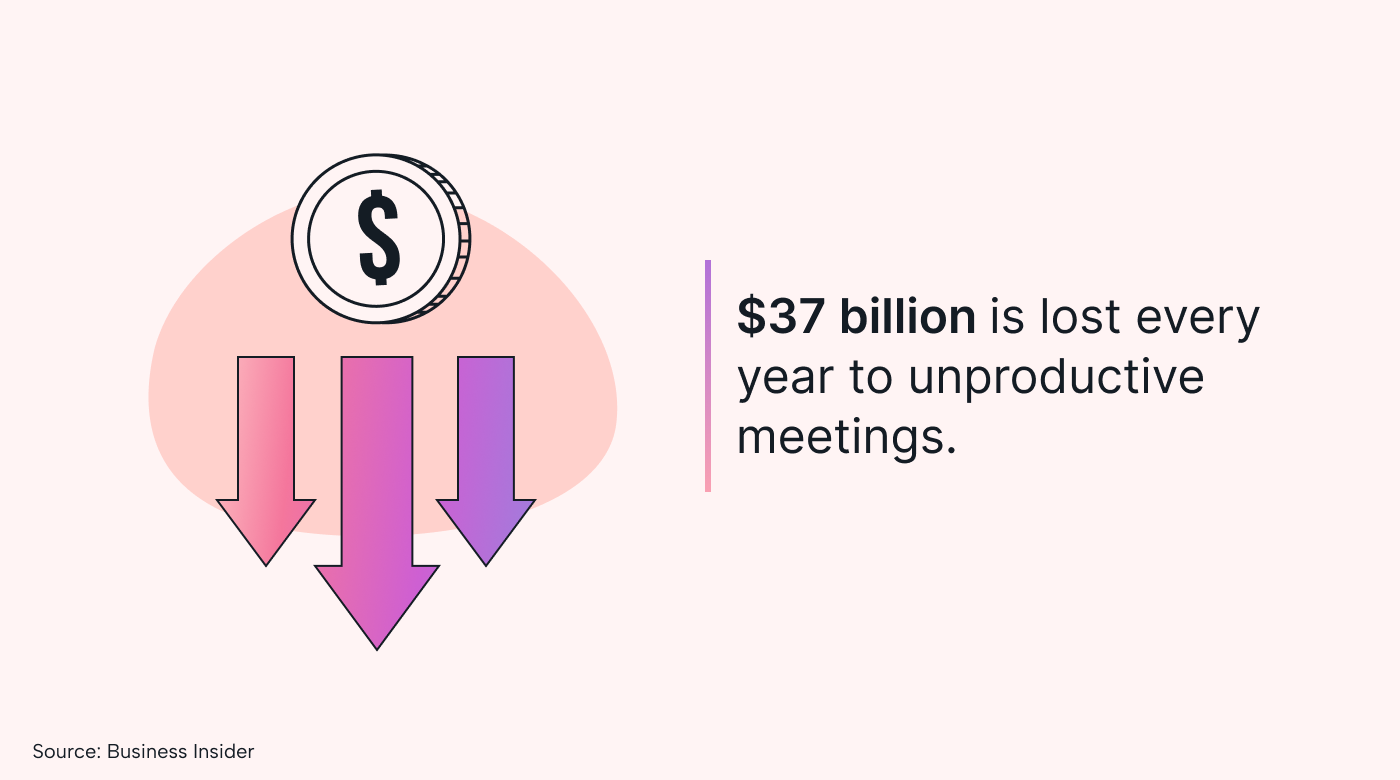 |
Defining a purpose and outlining a clear schedule before your meeting will help you effectively monitor its progress and steer the discussion back on track whenever it starts to deviate.
5 ways to manage your back-to-back meetings better
Meetings are unavoidable, but drowning in them doesn’t have to be your fate. With the right techniques and tools, it’s possible to transform your hectic meeting schedule into a manageable and productive component of your workday.
Here are a few tips:
1. Schedule purposeful downtime
Breaks between meetings are more than just a breather. They let you reset your mind, tackle cognitive overload, and provide opportunities for physical movement, countering the health risks associated with prolonged sitting. Additionally, these pauses allow for brief moments of reflection, which enhance decision-making and creativity.
Make a point to incorporate conscious, 10-minute breaks into your schedule.
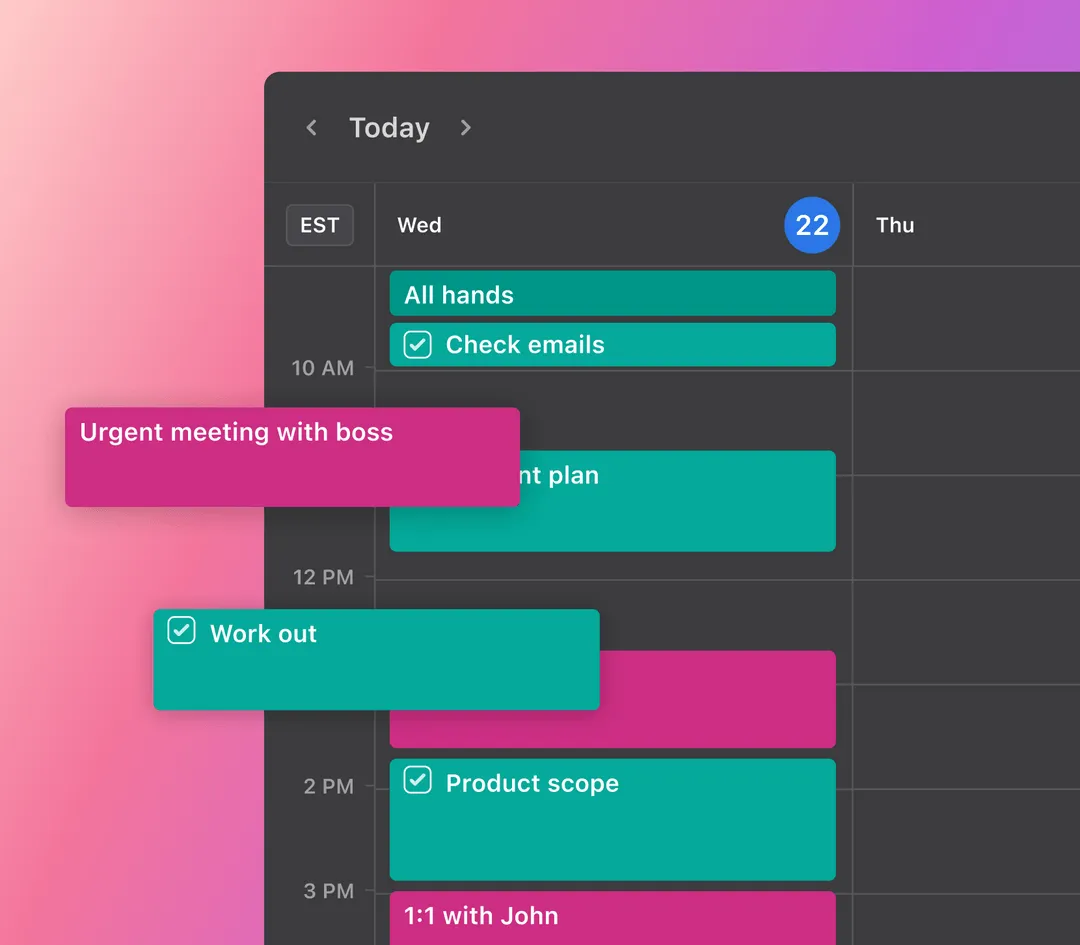 |
Tools like Motion can help you intentionally build breaks into your daily calendar and, ultimately, ensure that you take time for yourself and have a balanced and productive workday.
2. Set clear time limits
Setting time limits is a great way to make sure your meetings are concise and to the point. It also shows that you respect everyone’s time.
Consider adopting stand-up meetings. As the name suggests, these are conducted with the participants on their feet. Stand-up meetings encourage shorter meetings, which often lead to quicker decision-making and an energized meeting environment.
Additionally, Motion includes built-in time-tracking features that help you stick to the predefined time limits for each issue. It automatically notifies you when it's time to move on to the next idea, keeping your meeting on track.
3. Prioritize meetings that matter
Sometimes, you’ve got to say “no” to create space for your priorities.
“Prioritize” your participation by asking yourself if the meeting is relevant to your current projects, if your contribution is crucial to the meeting’s outcome, and whether the topics discussed could be handled via email or a quick call instead.
Choosing only to attend important and relevant meetings helps you maintain your energy level throughout the day and prevent the burnout that results from never-ending conferences.
Motion can help you set priorities for meetings and other tasks so you can focus on what truly matters. You can also set reminders to help keep you on track with these priorities.
4. Practice time-blocking
Time-blocking is a strategy that allocates specific time slots for different tasks to help ensure a balanced and structured workday. During these blocks, you focus only on the designated task. For example, you could block out 9 am to 11 am for focused work on a project, 11 am to 12 pm for responding to emails, and 1 pm to 3 pm for meetings.
This method creates clear boundaries, protects deep work sessions from interruptions, and improves focus and productivity.
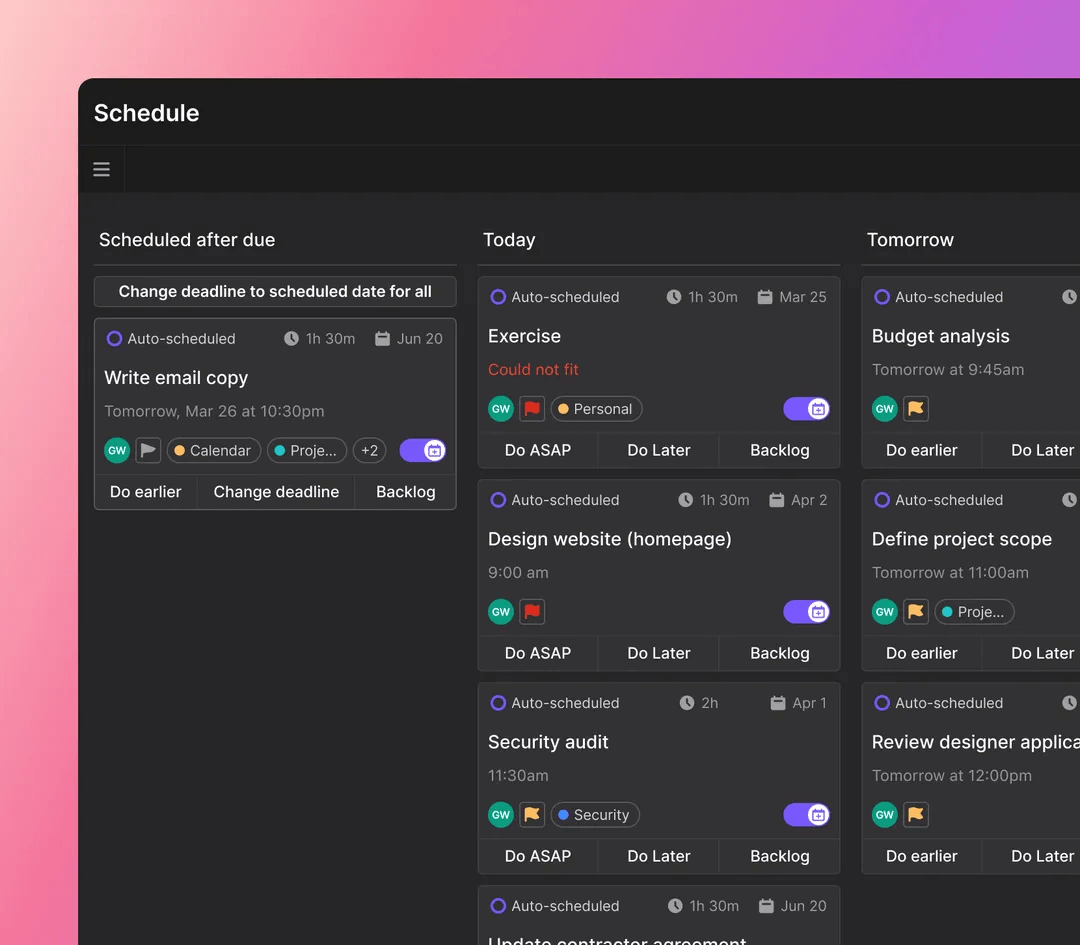 |
Motion can help facilitate a seamless transition between tasks and meetings by automatically blocking time for various tasks right on your calendar so you always know what’s next.
5. Improve your scheduling habits
Make your schedule work smarter, not harder.
Grouping similar meetings together reduces the mental load associated with switching between vastly different topics or projects.
Distributing meetings evenly throughout the week also gives you more flexibility and leaves room for surprise tasks or urgent matters that may arise.
Motion can create an optimized schedule for your team. Its Meeting Assistant also works with teams’ calendars to find those golden time slots that work for everyone. With Motion, you spend less time juggling tasks and more time actually doing them.
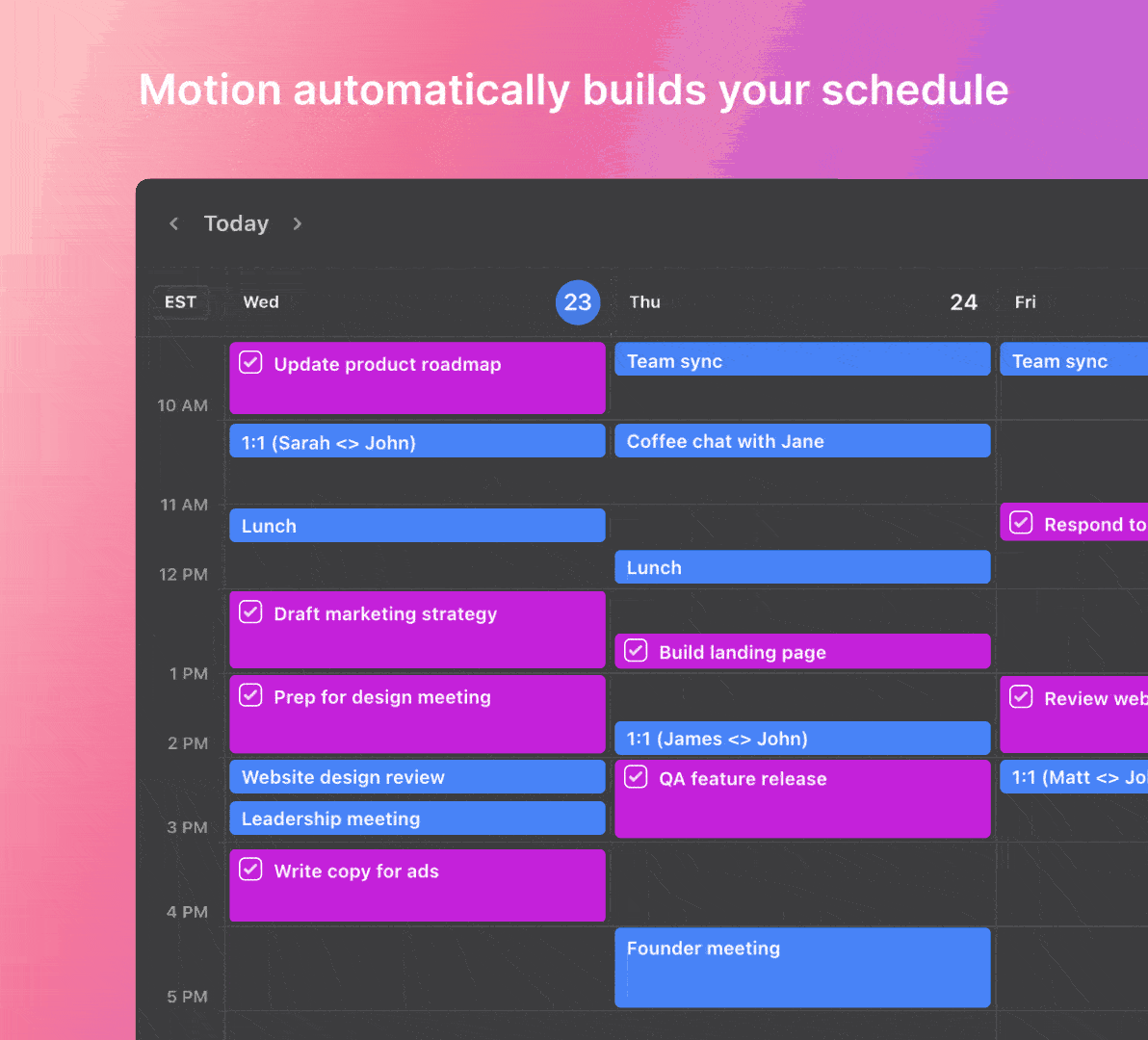 |
Revolutionize meeting management with Motion
Run meetings like a pro with Motion. We expertly organize and manage your schedule through the power of AI to ensure a balanced workflow and maximize the impact of your meetings.
Give Motion a try for a more productive workday.

